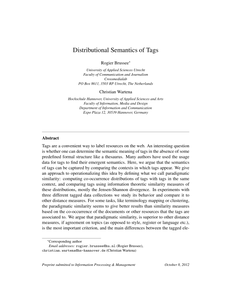Preprint submitted to Information Processing & Management Tags are a convenient way to label resources on the web. An interesting question is whether one can determine the semantic meaning of tags in the absence of some predefined formal structure like a thesaurus. Many authors have used the usage data for tags to find their emergent semantics. Here, we argue that the semantics of tags can be captured by comparing the contexts in which tags appear. We give an approach to operationalizing this idea by defining what we call paradigmatic similarity: computing co-occurrence distributions of tags with tags in the same context, and comparing tags using information theoretic similarity measures of these distributions, mostly the Jensen-Shannon divergence. In experiments with three different tagged data collections we study its behavior and compare it to other distance measures. For some tasks, like terminology mapping or clustering, the paradigmatic similarity seems to give better results than similarity measures based on the co-occurrence of the documents or other resources that the tags are associated to. We argue that paradigmatic similarity, is superior to other distance measures, if agreement on topics (as opposed to style, register or language etc.), is the most important criterion, and the main differences between the tagged elements in the data set correspond to different topics
DOCUMENT

In this paper we analyse the way students tag recorded lectures. We compare their tagging strategy and the tags that they create with tagging done by an expert. We look at the quality of the tags students add, and we introduce a method of measuring how similar the tags are, using vector space modelling and cosine similarity. We show that the quality of tagging by students is high enough to be useful. We also show that there is no generic vocabulary gap between the expert and the students. Our study shows no statistically significant correlation between the tag similarity and the indicated interest in the course, the perceived importance of the course, the number of lectures attended, the indicated difficulty of the course, the number of recorded lectures viewed, the indicated ease of finding the needed parts of a recorded lecture, or the number of tags used by the student.
LINK
Mediaorganisaties gebruiken veel foto’s uit beeldarchieven, bijvoorbeeld om bij nieuwsberichten te plaatsen. Met een tool die foto’s automatisch van tags voorziet willen we zorgen voor grotere consistentie en nauwkeurigheid in zulke beeldarchieven. Hiermee wordt het vinden van passende foto’s eenvoudiger.Doel We onderzoeken of het haalbaar is een tool voor het automatisch taggen van foto’s te ontwikkelen die goed om kan gaan met steeds nieuwe tags. In de context van nieuws en journalistiek moeten namelijk regelmatig nieuwe tags toe worden gevoegd. Resultaten In het project zoeken we antwoorden op onderstaande onderzoeksvragen: Hoe verhoudt de nauwkeurigheid van de tool zich tot die van een traditionele tool voor het taggen van foto’s? Blijft de tool voor automatisch taggen goed presteren als het aantal tags toeneemt? Hoeveel foto’s zijn minimaal nodig om de tool goed te laten presteren voor een nieuwe tag? Looptijd 01 maart 2023 - 01 juli 2023 Aanpak In the eerste fase van het project ontwikkelen we een tool die voldoet aan de gestelde eisen. Zodra de tool ontwikkeld en geïmplementeerd is, volgt de tweede fase. Hierin evalueren we de prestaties van de tool, ook wanneer nieuwe tags worden geïntroduceerd en worden gekoppeld aan foto’s.
Mediaorganisaties gebruiken veel foto’s uit beeldarchieven, bijvoorbeeld om bij nieuwsberichten te plaatsen. Met een tool die foto’s automatisch van tags voorziet willen we zorgen voor grotere consistentie en nauwkeurigheid in zulke beeldarchieven. Hiermee wordt het vinden van passende foto’s eenvoudiger.

Internet of Things (IoT) is tagging low power devices, miniaturized, with machine-readable identification tags, which are integrated with sensors to collect information and wireless technology to connect them with the Internet. These devices have a very low energy usage. Powering these devices with battery is very labor intensive, costly and tedious especially as number of nodes increases, which is in many applications, is the case. Hence the main objective of this proposal is to introduce new product called RF Colletor, in the market such that IoT devices function independent of battery. Using the suggested approach the wille be energized using Radio Frequency (RF) energy harvesting. RF Collector wirelessly capture the RF energy that is wasted in space, and re-use it again as the power source for IoT devices and hence making them autonomous of battery. The ability to harvest RF energy enables wireless charging of low-power devices in real time. This has resulting benefits to sustainability, cost reduction, product design, usability, and reliability.